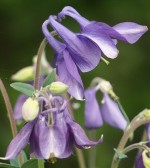 With a name like “granny’s bonnet” this plant is bound to raise the curiosity of any gardener. As one of 65 species of columbine, this is not the best known, but it is a fine garden plant and a common resident in a traditional English cottage garden. It is a herbaceous perennial native to woodlands and meadows of Europe, and a member of the buttercup family, Ranunculaceae, that also includes delphinium, clematis, and monkshood. Plants grow 18-36″ tall and form clumps of thin, branching stems with leaves that have three groups of three leaflets. The nodding or upright flowers appear in spring to summer and have a central column of stamens surrounded by five petals with spurs and five petal-like sepals. The short incurved spurs that end in small knobs give a unique charm to the flowers and make them particularly attractive when pressed and dried. Many cultivars and hybrids of A. vulgaris have been produced that are double, semi double, and spurless. Plants may be short lived but reseed and naturalize. Plant them far from other columbines as they readily hybridize. Common columbine is a good choice for garden borders as well as cottage, shade, woodland, and rock gardens. Its common name, granny’s bonnet, comes from the resemblance of the spreading petals to a bonnet. The genus name, Aquilegia, comes from the Latin word aquila meaning eagle and perhaps refers to the resemblance of the spurs to the talons of an eagle. The specific epithet, vulgaris, is the Latin word meaning common.
With a name like “granny’s bonnet” this plant is bound to raise the curiosity of any gardener. As one of 65 species of columbine, this is not the best known, but it is a fine garden plant and a common resident in a traditional English cottage garden. It is a herbaceous perennial native to woodlands and meadows of Europe, and a member of the buttercup family, Ranunculaceae, that also includes delphinium, clematis, and monkshood. Plants grow 18-36″ tall and form clumps of thin, branching stems with leaves that have three groups of three leaflets. The nodding or upright flowers appear in spring to summer and have a central column of stamens surrounded by five petals with spurs and five petal-like sepals. The short incurved spurs that end in small knobs give a unique charm to the flowers and make them particularly attractive when pressed and dried. Many cultivars and hybrids of A. vulgaris have been produced that are double, semi double, and spurless. Plants may be short lived but reseed and naturalize. Plant them far from other columbines as they readily hybridize. Common columbine is a good choice for garden borders as well as cottage, shade, woodland, and rock gardens. Its common name, granny’s bonnet, comes from the resemblance of the spreading petals to a bonnet. The genus name, Aquilegia, comes from the Latin word aquila meaning eagle and perhaps refers to the resemblance of the spurs to the talons of an eagle. The specific epithet, vulgaris, is the Latin word meaning common.
Type: Herbaceous perennial
Bloom: 1 1/2 – 2″ blue short spurred flowers in spring
Size: 1.5-3’ H x 1-2’ W
Light: Full sun to part shade
Soil: Average to rich, medium moist, well-drained
Fertilizer: Apply complete fertilizer in spring.
Hardiness: Zones 3-8
Care: Remove blooming stems after flowering to encourage 2nd bloom. Cut to the ground if/when foliage declines.
Pests and Diseases: Borers; leaf miners can be a problem but if foliage is cut back when their tunnels appear in the leaves, a new mound will appear.
Propagation: Fresh seed, but plants often not true because of tendency to hybridize; as seeds age germination becomes more difficult. Division in spring.
Companion Plants: Cranesbill (Geranium spp.), evening primroses, iris, peony, lupine, amsonia, and baptisia.
Outstanding Selection: Var. nivae (white flowers, 3’ tall).
Photo Credit: Wikipedia
